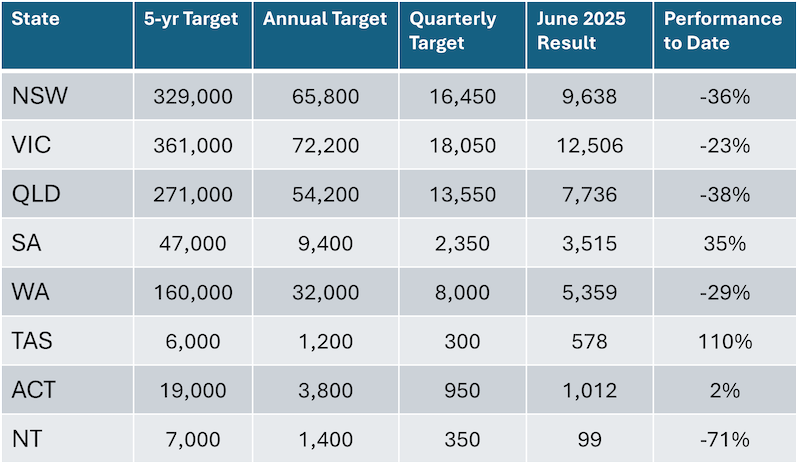ABS Reveals 174,000 Homes Delivered in Accord’s First Year

Just how far Australia has fallen short of the targets set under the National Housing Accord has been revealed.
New data from the Australian Bureau of Statistics shows that in the first full year of the accord, only 174,000 new homes were delivered, well below the target of 240,000.
The June 2025 quarter produced just 40,254 new homes, down 6.5 per cent on the previous quarter and 12.5 per cent below the same quarter a year earlier.
Detached house starts declined 6.4 per cent to their weakest quarter since March 2024, while higher density home starts fell by 1.7 per cent.
The states with the largest shortfalls were Queensland, down 38 per cent, New South Wales, down 36 per cent, and Victoria, down 23 per cent.
Master Builders Australia chief executive Denita Wawn described the results as a “needs improvement report card” for the accord.
She said the industry was ready to deliver but required government reforms to accelerate approvals, streamline regulation, address skills shortages and support private investment.
Master Builders chief economist Shane Garrett said the shortfall meant an average of 255,300 new homes a year were now required over the remaining four years to meet the five-year target of 1.2 million homes.
Urban Taskforce chief executive Tom Forrest said the figures showed the market may be turning a corner but warned that further support for housing-related infrastructure from the Commonwealth and state governments was critical to sustaining supply growth and improving affordability for first-home buyers.

While governments have made progress in implementing policies to encourage new home supply, industry representatives urged further action to overcome ongoing regulatory and market challenges.
The data underscored that without co-ordinated government intervention, Australia risks falling further behind in meeting its housing supply ambitions, with implications for affordability and access to new homes across the nation.
But Oliver Hume chief economist Matt Bell said a year into a five-year target there had been a significant change in attitude from the public and governments when it comes to the prioritisation of new home supply over the interests of existing homeowners.
“State governments have made meaningful progress in the past six months to put in place policies that support new home supply, especially in our most populous capitals of Sydney and Melbourne,” Bell said.
“They should be encouraged to push further on this front rather than throwing our hands up in despair at how ambitious the target is. There’s still four years to go.
“A rise in building activity is the key element to improve affordability outcomes for first home buyers over the long term. We should be optimistic.”













